小学英语课程与教学论(B)
探究式互动教学策略研究——以《小学英语课程与教学论》为例
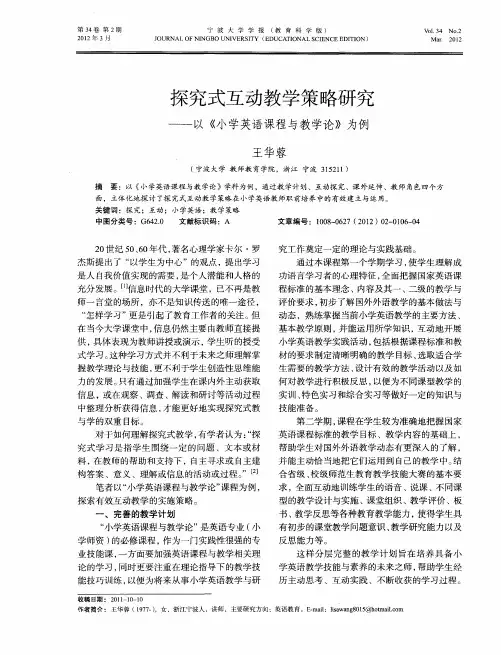
2 世 纪 5 、0 代 , O 06 年 著名 心理 学家 卡尔 ・ 罗 杰 斯提 出了 “ 以学 生 为 中心”的观点 ,提 出学 习 是 人 自我价 值 实现 的需要 , 是个 人潜 能 和人格 的 充 分发 展 。I信 息时代 的大学课 堂 ,已不 再 是教 J J 师 一 言堂 的场所 ,亦 不是 知识 传送 的唯一途 径 ,
实训 、 特色实习和综合实习等做好一定的知识与
技 能准备 。 第二 学期 , 程在学 生 较 为准确 地把 握 国家 课 英语 课程 标 准 的教 学 目标 、教 学 内容 的基础 上 ,
帮 助学生 对 国外外 语 教学 动态 有更 深入 的 了解 ,
对于 如何 理解探 究 式教 学 , 有学 者认 为 :探 “
究式 学 习是Βιβλιοθήκη 指 学 生 围绕 一 定 的 问题 、文 本 或材
料 , 教 师 的帮助 和支持 下 ,自主 寻求 或 自主建 在
并 能主 动恰 当地把 它们 运用 到 自己的教 学 中 。 结 合 省级 、 校级 师范 生教 育教 学技 能大 赛 的基 本要
构答案 、意义、理解或信息的活动或过程 。 2 ”L J 笔者 以“ 小学英语课程与教学论 ” 课程为例 , 探索 有效 互动 教学 的实 施策 略 。
究工 作奠 定一 定 的理论 与实 践基 础 。 通过 本课 程第 一个 学期 学 习 , 学生 理解 成 使 功语 言学 习者 的心 理特 征 , 面把握 国家 英语课 全 程标 准 的基本 理念 、内容及 其一 、 二级 的教学 与
评价要求 , 初步了解 国外外语教学的基本做法与
动态 ,熟 练掌 握 当前小 学英 语教 学 的 主要方 法 、 基本 教学 原则 , 能运 用所 学知 识 , 动 地开 展 并 互 小 学英语 教 学实践 活 动 , 括根 据课 程标 准 和教 包
小学英语课程与教学论试卷
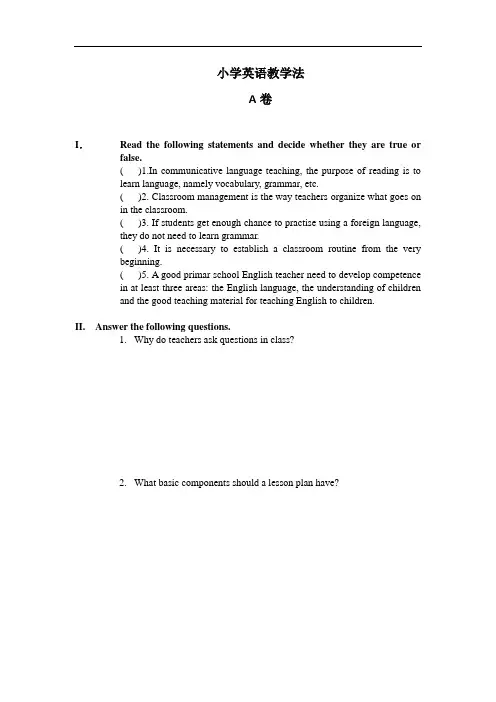
小学英语教学法A卷I.Read the following statements and decide whether they are true or false.( )1.In communicative language teaching, the purpose of reading is tolearn language, namely vocabulary, grammar, etc.( )2. Classroom management is the way teachers organize what goes onin the classroom.( )3. If students get enough chance to practise using a foreign language,they do not need to learn grammar.( )4. It is necessary to establish a classroom routine from the verybeginning.( )5. A good primar school English teacher need to develop competencein at least three areas: the English language, the understanding of childrenand the good teaching material for teaching English to children.II. Answer the following questions.1.Why do teachers ask questions in class?2.What basic components should a lesson plan have?3.What are the overall objectives for Level 2?4.What makes a good primary English teacher?II.Read the following situations and the teacher’s behaviour. Are the teachers motivating learners or demotivating them? What are thereasons hehind these behaviours? If you do not like any of these, cancan you improve them?Situation 1: The teacher is showing a very exciting cartoon and thepurpose is to ask children to pick up what is being said in the cartoon. Thechildren get so excited that they stand up and move with the music. Theteacher gets very angry and she says:------再有一个人起来我就关掉了,不看了。
小学英语课程与教学论智慧树知到答案章节测试2023年潍坊学院
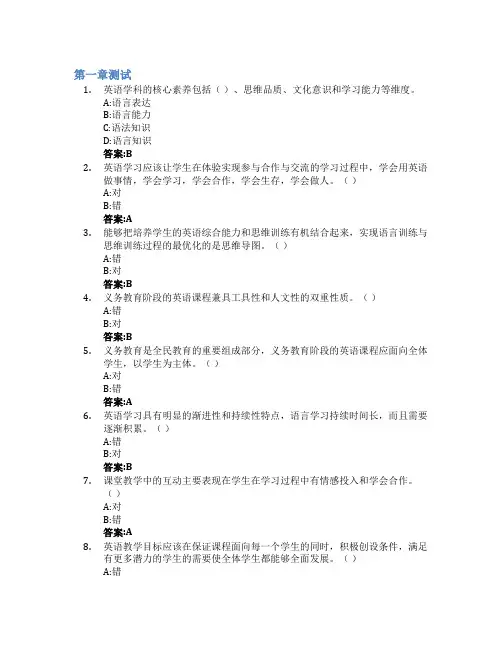
第一章测试1.英语学科的核心素养包括()、思维品质、文化意识和学习能力等维度。
A:语言表达B:语言能力C:语法知识D:语言知识答案:B2.英语学习应该让学生在体验实现参与合作与交流的学习过程中,学会用英语做事情,学会学习,学会合作,学会生存,学会做人。
()A:对B:错答案:A3.能够把培养学生的英语综合能力和思维训练有机结合起来,实现语言训练与思维训练过程的最优化的是思维导图。
()A:错B:对答案:B4.义务教育阶段的英语课程兼具工具性和人文性的双重性质。
()A:错B:对答案:B5.义务教育是全民教育的重要组成部分,义务教育阶段的英语课程应面向全体学生,以学生为主体。
()A:对B:错答案:A6.英语学习具有明显的渐进性和持续性特点,语言学习持续时间长,而且需要逐渐积累。
()A:错B:对答案:B7.课堂教学中的互动主要表现在学生在学习过程中有情感投入和学会合作。
()A:对B:错答案:A8.英语教学目标应该在保证课程面向每一个学生的同时,积极创设条件,满足有更多潜力的学生的需要使全体学生都能够全面发展。
()A:错答案:B9.师生感情是培养学生对英语教学内容发生兴趣的关键。
()A:错B:对答案:B第二章测试1.《英语课程标准》将英语课程的目标总共分为()个能力级别。
A:6B:7C:5D:9答案:D2.()是从学生的学习心理入手,分析、研究教材和教学中的心理因素。
A:心理分析法B:知识分析法C:结构分析法D:方法论分析法答案:A3.现在国内常用的小学英语教材主要有()。
A:外研社小学英语教材B:人民教育出版社小学英语教材C:外文原版教材D:上海版牛津英语答案:ABD4.《英语课程标准》明确了语法的三个维度:形式、意义和运用,明确了语法教学要使三者有效的结合。
()A:错B:对答案:B5.进行教材分析时,教师首先要通读本阶段教学所选用的教材,研究()。
A:单元话题B:活动C:语言材料D:语言点答案:ABCD6.教材分析的基本步骤有三步,分别是研读课程标准,通读教材,分析内容。
《小学英语课程与教学论》教学大纲
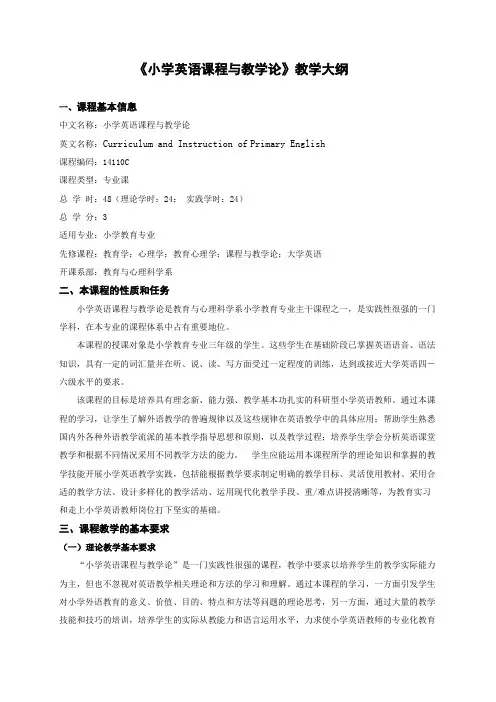
《小学英语课程与教学论》教学大纲一、课程基本信息中文名称:小学英语课程与教学论英文名称:Curriculum and Instruction of Primary English课程编码:14110C课程类型:专业课总学时:48(理论学时:24;实践学时:24)总学分:3适用专业:小学教育专业先修课程:教育学;心理学;教育心理学;课程与教学论;大学英语开课系部:教育与心理科学系二、本课程的性质和任务小学英语课程与教学论是教育与心理科学系小学教育专业主干课程之一,是实践性很强的一门学科,在本专业的课程体系中占有重要地位。
本课程的授课对象是小学教育专业三年级的学生。
这些学生在基础阶段已掌握英语语音、语法知识,具有一定的词汇量并在听、说、读、写方面受过一定程度的训练,达到或接近大学英语四-六级水平的要求。
该课程的目标是培养具有理念新、能力强、教学基本功扎实的科研型小学英语教师。
通过本课程的学习,让学生了解外语教学的普遍规律以及这些规律在英语教学中的具体应用;帮助学生熟悉国内外各种外语教学流派的基本教学指导思想和原则,以及教学过程;培养学生学会分析英语课堂教学和根据不同情况采用不同教学方法的能力。
学生应能运用本课程所学的理论知识和掌握的教学技能开展小学英语教学实践,包括能根据教学要求制定明确的教学目标、灵活使用教材、采用合适的教学方法、设计多样化的教学活动、运用现代化教学手段、重/难点讲授清晰等,为教育实习和走上小学英语教师岗位打下坚实的基础。
三、课程教学的基本要求(一)理论教学基本要求“小学英语课程与教学论”是一门实践性很强的课程,教学中要求以培养学生的教学实际能力为主,但也不忽视对英语教学相关理论和方法的学习和理解。
通过本课程的学习,一方面引发学生对小学外语教育的意义、价值、目的、特点和方法等问题的理论思考,另一方面,通过大量的教学技能和技巧的培训,培养学生的实际从教能力和语言运用水平,力求使小学英语教师的专业化教育做到起点高、专业性强,既重理论,也重实践,着眼于小学英语教师的终身学习和可持续发展能力的培养。
《课程与教学论》教学大纲
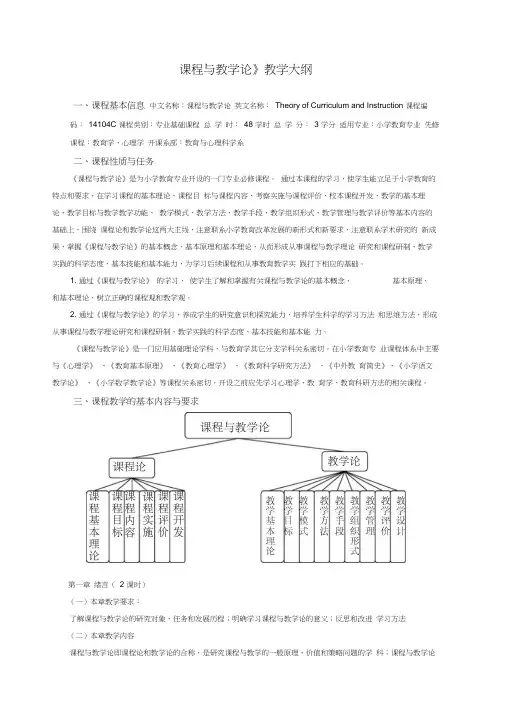
课程与教学论》教学大纲一、课程基本信息中文名称:课程与教学论英文名称:Theory of Curriculum and Instruction 课程编码:14104C 课程类别:专业基础课程总学时:48 学时总学分:3 学分适用专业:小学教育专业先修课程:教育学、心理学开课系部:教育与心理科学系二、课程性质与任务《课程与教学论》是为小学教育专业开设的一门专业必修课程。
通过本课程的学习,使学生能立足于小学教育的特点和要求,在学习课程的基本理论、课程目标与课程内容、考察实施与课程评价、校本课程开发、教学的基本理论、教学目标与教学教学功能、教学模式、教学方法、教学手段、教学组织形式、教学管理与教学评价等基本内容的基础上,围绕课程论和教学论这两大主线,注意联系小学教育改革发展的新形式和新要求,注意联系学术研究的新成果,掌握《课程与教学论》的基本概念、基本原理和基本理论,从而形成从事课程与教学理论研究和课程研制、教学实践的科学态度、基本技能和基本能力,为学习后续课程和从事教育教学实践打下相应的基础。
1. 通过《课程与教学论》的学习,使学生了解和掌握有关课程与教学论的基本概念、基本原理、和基本理论,树立正确的课程观和教学观。
2. 通过《课程与教学论》的学习,养成学生的研究意识和探究能力,培养学生科学的学习方法和思维方法,形成从事课程与教学理论研究和课程研制、教学实践的科学态度、基本技能和基本能力。
《课程与教学论》是一门应用基础理论学科,与教育学其它分支学科关系密切。
在小学教育专业课程体系中主要与《心理学》、《教育基本原理》、《教育心理学》、《教育科学研究方法》、《中外教育简史》、《小学语文教学论》、《小学数学教学论》等课程关系密切,开设之前应先学习心理学、教育学、教育科研方法的相关课程。
三、课程教学的基本内容与要求第一章绪言(2 课时)(一)本章教学要求:了解课程与教学论的研究对象、任务和发展历程;明确学习课程与教学论的意义;反思和改进学习方法(二)本章教学内容课程与教学论即课程论和教学论的合称,是研究课程与教学的一般原理、价值和策略问题的学科;课程与教学论经历了长期的发展演变,有多种流派和不同体系;掌握课程与教学的基本原理、价值和策略,是小学教师专业化的重要要求;学好这一科目,需要掌握好学科基本结构,加强理论与实践的联系,改进学习方法,提高学习效能。
(完整版)英语课程与教学论试题及答案
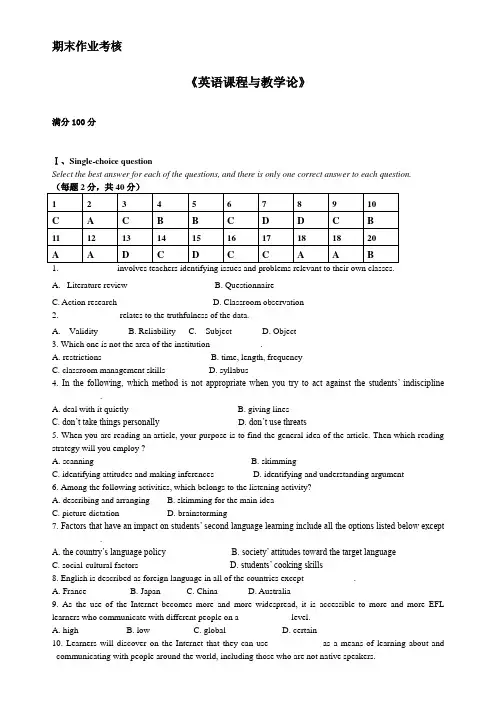
期末作业考核《英语课程与教学论》满分100分Ⅰ、Single-choice questionSelect the best answer for each of the questions, and there is only one correct answer to each question.A.Literature reviewB. QuestionnaireC. Action researchD. Classroom observation2. ___________ relates to the truthfulness of the data.A. ValidityB. ReliabilityC. SubjectD. Object3. Which one is not the area of the institution ___________.A. restrictionsB. time, length, frequencyC. classroom management skillsD. syllabus4. In the following, which method is not appropriate when you try to act against the students’ indiscipline ___________.A. deal with it quietlyB. giving linesC. don’t take things personallyD. don’t use threats5. When you are reading an article, your purpose is to find the general idea of the article. Then which reading strategy will you employ ? ___________A. scanningB. skimmingC. identifying attitudes and making inferencesD. identifying and understanding argument6. Among the following activities, which belongs to the listening activity? ___________A. describing and arrangingB. skimming for the main ideaC. picture dictationD. brainstorming7. Factors that have an impact on students’ second language learning include all the options listed below except ___________.A. the country’s language policyB. society’ attitudes toward the target languageC. social-cultural factorsD. students’ cooking skills8. English is described as foreign language in all of the countries except ___________.A. FranceB. JapanC. ChinaD. Australia9. As the use of the Internet becomes more and more widespread, it is accessible to more and more EFL learners who communicate with different people on a ___________ level.A.highB. lowC. globalD. certain10. Learners will discover on the Internet that they can use ___________ as a means of learning about and communicating with people around the world, including those who are not native speakers.A.ChineseB. EnglishC. GermanD. French11. Intralingual errors originate with the structure of ___________.A. the target languageB. the native languageC. the foreign languageD. the second language12. Interference errors are caused by the influence of the ___________.A. native languageB. the target languageC. the foreign languageD. the second language13. When a teacher chooses the model for students to imitate the pronunciation, which of the following optionsis not mentioned that teacher should consider ___________.A.accentB. genreC. styleD. context14. What is the function of the sentence “Give me that book”? ___________A.requestB. instructionC. orderD. invitation15. What should not teacher do in the class about individual student’s own purposes? ___________A. Help to discover the purposes.B. Help to formulate the purposes.C. Help to clarify the purposes.D. Help to set the purposes.16. Which opinion of using English in the classroom is wrong? ___________A. Students will be practicing unconsciously a number of language skills.B. Students will learning how to pick out key words.C. Students will increase the interference from their mother tongue.D. Students will begin to think in English for themselves.17. For most people the term “curriculum” includ es those activities that educators have devised for___________, which are represented in the form of a written document.A. teachersB. designersC. learnersD. students18. In L2 learning the established understanding is typified by___________ syllabus.A. Formal and functionalB. structural and functionalC. formal and structuralD. type A and type B19. L2 learners construct a linguistic system that draws, in part, on the learners L1 but is also different from itand also from the target language. This linguistic system is referred to as ______.A. InterlanguageB. Mother tongueC. Target languageD. Native language20. Repeating, imitating and recitation are considered to be ______ learning activities.A. StructuralistB. CognitiveC. CommunicativeD. BehavioristⅡ、Multiple-choice questionSelect the best answer for each of the questions, and there are more than one correct answers to each question.(每题2分,共20分)A. A. interviewsB. examination of textsC. collection of dataD. ethnographic observations1. 2. What are the major areas of the profession ___________.A. the aids available for the levelB. the language for the levelC. physical conditionsD. a repertoire of activitiesE. who the students areF. stages and techniques in teachingG. the skills for the level2. 3. In the following, which are the differences between oral and written communication? ___________3. A. Range of expressive possibilitiesB. Clearness of expressionC. FeedbackD. Need for accuracy4. Teaching can be defined as ___________.A. giving instructionsB. guiding in the study of somethingC. providing with knowledgeD. causing to understand5. Some Internet activities give students ___________and ___________ feedback by automatically correctingtheir on-line exercises.A. neutralB. positiveC. negativeD. no6. For elicitation technique, teachers can ask questions like ___________.A. How do we say that in English?B. It’s a....C. Say that againD. yes/no response7. Which of the following sayings are right according to this chapter? ___________A.Students should learn both the form and the meaning of a language item.B.Meaning has no relation with the contextC.both the teacher and students need to be aware of the fact that form does not equal meaning and vice versaD.students don’t need to learn how t o use the language8. What are the ways to maximize interaction? ___________A. Encourage a friendly, relaxed learning environmentB. Ask questions rather than giving explanation.C. Create competitive interaction.D. Allow students to finish their own sentences9. Curriculum is an educational program which states the following___________.A. the educational purpose of the programB. the content, teaching procedures and learning experience which will be necessary to achieve this purpose.C. Some means for assessing whether or not the educational ends have been achieved.D. The educational purpose of the vocabulary10. Sensory Modality Strength categorizes learners as ?A. VisualB. AuditoryC. Tactile-kinestheticD. AnalyticalE. ThinkingIII. True or False1分,共10分)1. Qualitative method is a research method that relies less on numbers and statistics but more on interviews,observations, small numbers of questionnaires.2. Goal usually refers to the overall purpose or aim that a teacher will attempt to accomplish by the end of the class period.3. It is often true that one skill can be performed without another.4. The extent and type of prior knowledge isn’t an essential consideration in planning instruct ion.5. The World Wide Web makes it possible for students to experience a lot of situations which would be impossible in the traditional classroom.6. Minute paper is a simple way to collect written feedback on student learning.7. One single letter is pronounced differently in different words.8. If teachers do not have enough time, they could finish abruptly or run on after bell.9. Curriculum and syllabus can represent the same theory of learning and can be realized in various ways.10. Introverts seek out company actively and enjoy the company of other people.Ⅳ、Short answer questions(每题15分,共30分)1. Please list the possible formative assessment activities.Tips: 1) list at least three ways.2) How are they used in college?Three modules, students’ portfolios, teachers’ observation records and assessment ar chives of learning effects, shown as below:2. Why is interaction so important in language-learning situations?Through interaction, students can increase their language store as they listen to or read authentic linguistic material, or even the output of their fellow students in discussion, skits, joint problem-solving tasks, or dialogue journal. In interaction, students can use all they possess of the language – all they have learned or casually absorbed in real life – to exchange their meaning. They thus have experience in creating messages from what they have heard, since comprehension is a process of creation, and in creating discourse they can convey their intensions.。
(完整)英语课程与教学论试题及答案,推荐文档
期末作业考核《英语课程与教学论》满分100分Ⅰ、Single-choice questionSelect the best answer for each of the questions, and there is only one correct answer to each question.A.Literature reviewB. QuestionnaireC. Action researchD. Classroom observation2. ___________ relates to the truthfulness of the data.A. ValidityB. ReliabilityC. SubjectD. Object3. Which one is not the area of the institution ___________.A. restrictionsB. time, length, frequencyC. classroom management skillsD. syllabus4. In the following, which method is not appropriate when you try to act against the students’ indiscipline ___________.A. deal with it quietlyB. giving linesC. don’t take things personallyD. don’t use threats5. When you are reading an article, your purpose is to find the general idea of the article. Then which reading strategy will you employ ? ___________A. scanningB. skimmingC. identifying attitudes and making inferencesD. identifying and understanding argument6. Among the following activities, which belongs to the listening activity? ___________A. describing and arrangingB. skimming for the main ideaC. picture dictationD. brainstorming7. Factors that have an impact on students’ second language learning include all the options listed below except ___________.A. the country’s language policyB. society’ attitudes toward the target languageC. social-cultural factorsD. students’ cooking skills8. English is described as foreign language in all of the countries except ___________.A. FranceB. JapanC. ChinaD. Australia9. As the use of the Internet becomes more and more widespread, it is accessible to more and more EFL learners who communicate with different people on a ___________ level.A.highB. lowC. globalD. certain10. Learners will discover on the Internet that they can use ___________ as a means of learning about and communicating with people around the world, including those who are not native speakers.A.ChineseB. EnglishC. GermanD. French11. Intralingual errors originate with the structure of ___________.A. the target languageB. the native languageC. the foreign languageD. the second language12. Interference errors are caused by the influence of the ___________.A. native languageB. the target languageC. the foreign languageD. the second language13. When a teacher chooses the model for students to imitate the pronunciation, which of the following optionsis not mentioned that teacher should consider ___________.A.accentB. genreC. styleD. context14. What is the function of the sentence “Give me that book”? ___________A.requestB. instructionC. orderD. invitation15. What should not teacher do in the class about individual student’s own purposes? ___________A. Help to discover the purposes.B. Help to formulate the purposes.C. Help to clarify the purposes.D. Help to set the purposes.16. Which opinion of using English in the classroom is wrong? ___________A. Students will be practicing unconsciously a number of language skills.B. Students will learning how to pick out key words.C. Students will increase the interference from their mother tongue.D. Students will begin to think in English for themselves.17. For most people the term “curriculum” includ es those activities that educators have devised for___________, which are represented in the form of a written document.A. teachersB. designersC. learnersD. students18. In L2 learning the established understanding is typified by___________ syllabus.A. Formal and functionalB. structural and functionalC. formal and structuralD. type A and type B19. L2 learners construct a linguistic system that draws, in part, on the learners L1 but is also different from itand also from the target language. This linguistic system is referred to as ______.A. InterlanguageB. Mother tongueC. Target languageD. Native language20. Repeating, imitating and recitation are considered to be ______ learning activities.A. StructuralistB. CognitiveC. CommunicativeD. BehavioristⅡ、Multiple-choice questionSelect the best answer for each of the questions, and there are more than one correct answers to each question.(每题2分,共20分)A. A. interviewsB. examination of textsC. collection of dataD. ethnographic observations1. 2. What are the major areas of the profession ___________.A. the aids available for the levelB. the language for the levelC. physical conditionsD. a repertoire of activitiesE. who the students areF. stages and techniques in teachingG. the skills for the level2. 3. In the following, which are the differences between oral and written communication? ___________3. A. Range of expressive possibilitiesB. Clearness of expressionC. FeedbackD. Need for accuracy4. Teaching can be defined as ___________.A. giving instructionsB. guiding in the study of somethingC. providing with knowledgeD. causing to understand5. Some Internet activities give students ___________and ___________ feedback by automatically correctingtheir on-line exercises.A. neutralB. positiveC. negativeD. no6. For elicitation technique, teachers can ask questions like ___________.A. How do we say that in English?B. It’s a....C. Say that againD. yes/no response7. Which of the following sayings are right according to this chapter? ___________A.Students should learn both the form and the meaning of a language item.B.Meaning has no relation with the contextC.both the teacher and students need to be aware of the fact that form does not equal meaning and vice versaD.students don’t need to learn how t o use the language8. What are the ways to maximize interaction? ___________A. Encourage a friendly, relaxed learning environmentB. Ask questions rather than giving explanation.C. Create competitive interaction.D. Allow students to finish their own sentences9. Curriculum is an educational program which states the following___________.A. the educational purpose of the programB. the content, teaching procedures and learning experience which will be necessary to achieve this purpose.C. Some means for assessing whether or not the educational ends have been achieved.D. The educational purpose of the vocabulary10. Sensory Modality Strength categorizes learners as ?A. VisualB. AuditoryC. Tactile-kinestheticD. AnalyticalE. ThinkingIII. True or False1分,共10分)1. Qualitative method is a research method that relies less on numbers and statistics but more on interviews,observations, small numbers of questionnaires.2. Goal usually refers to the overall purpose or aim that a teacher will attempt to accomplish by the end of the class period.3. It is often true that one skill can be performed without another.4. The extent and type of prior knowledge isn’t an essential consideration in planning instruct ion.5. The World Wide Web makes it possible for students to experience a lot of situations which would be impossible in the traditional classroom.6. Minute paper is a simple way to collect written feedback on student learning.7. One single letter is pronounced differently in different words.8. If teachers do not have enough time, they could finish abruptly or run on after bell.9. Curriculum and syllabus can represent the same theory of learning and can be realized in various ways.10. Introverts seek out company actively and enjoy the company of other people.Ⅳ、Short answer questions(每题15分,共30分)1. Please list the possible formative assessment activities.Tips: 1) list at least three ways.2) How are they used in college?Three modules, students’ portfolios, teachers’ observation records and assessment ar chives of learning effects, shown as below:2. Why is interaction so important in language-learning situations?Through interaction, students can increase their language store as they listen to or read authentic linguistic material, or even the output of their fellow students in discussion, skits, joint problem-solving tasks, or dialogue journal. In interaction, students can use all they possess of the language – all they have learned or casually absorbed in real life – to exchange their meaning. They thus have experience in creating messages from what they have heard, since comprehension is a process of creation, and in creating discourse they can convey their intensions.。
小学英语课程与教学论内容
小学英语课程与教学论内容篇一:小学英语课程与教学论复习重点第一章小学英语教育的内涵:指向学生的发展。
小学英语教育的具体内容:1、为学生的终身发展打基础。
(基础性)2、为学生的知识获取、技能学习、素质培养等打基础,具有未来性。
3、促进学生的全面发展。
(全面性)4、面向全体学生。
(全体性)5、是一门必修课,具有强制性。
(强制性)小学英语教育的性质:既有英语教育学的性质,又有小学教育学的性质;既是小学阶段的英语教育学,又是英语学科的教育学。
1、是小学教育学与学科教育学的分支学科;2、是语言教育学的分支学科;3、是培养小学生英语基础知识与能力的学科;4、是以小学英语教育学理论与实践经验为指导的学科;5、是为小学英语教学提供教与学理论的重要来源;6、是为小学英语教学改革与发展提供理论依据与实践方法的学科。
小学英语课程的内容:两级内容一级内容1、总体目标:听、说、玩、读、演2、具体内容:对英语的兴趣和好奇心、口头表达能力3、内容分析:理解简单的活动指令、参与简单的角色扮演、唱简单的歌曲歌谣、听/读懂简单故事、正确书写单词字母、视听接触语音。
二级内容1、总体目标:语言技能、语音知识2、具体内容:语言技能(听、说、读、写、玩演视听);语音知识(语音、词汇、语法、功能、话题、情感态度、基础学习策略、文化意识)3、内容分析:有持续的兴趣和爱好英语课程设置的原则:整体性、多元性、灵活性实践要求:师范生应该能够较全面的理解具体内容与要求,并能够比较熟练地示范,如听录音后声情并茂地模仿,唱歌,说歌谣。
总之,要求学生做到的,老师必须要先做到。
中国英语教学存在的问题:问题一:费时多,收效微。
问题二:教师工作量太大,顾此失彼。
问题三:学生怕苦,兴趣不持久。
问题四:交际练习没有信息差,交际活动在不真实的语境中进行,学生在现实生活中不会运用。
问题五:家长水平有限,课后无法辅导。
问题六:教材难度大,学生消化不良。
问题七:教师英语素质不理想。
小学英语课程与教学论.ppt
小学阶段英语课程的任务
落实“教育要面向现代化,面向世界,面向未 来”的战略指导思想。
培养新世纪公民和现代人的英语语言素质。 使学生掌握一定的英语基础知识和听、说、读、
写技能,形成一定的综合语言运用能力。 保护学生学习英语的兴趣,培养良好的学习习
惯,形成有效的学习策略。
Teaching & Learning philosophies
(4)Choose what to say: long-term memory (practice)(素养)
(5)Just say it: say sth. learned, long-term memory. ( 自动化)
(1)&(2) are often omitted by us. (3) is also omitted some times
小学英语课程与教学论
金学军 2011.2 井冈山大学教育学院
第一章 绪论
第一节 小学英语教学的意义及目的 第二节 研究和学习小学英语教学法的 意义及方法 第三节 小学英语教学法中的相关观念
第一章 绪论
第一节 小学英语教学的意义及目的 第二节 研究和学习小学英语教学法的意义及
方法 第三节 小学英语教学法中语言观、学习观、
教学原则,教学过程,教学模式,教学评 价……);课程原理(社会要求,专业目标, 课程标准,素材选择,课程评价……)
Teaching & Learning philosophies
1.Start with listening & go on speaking (1)Listen: as much as possible, using aural
《英语课程与教学论》试题与答案
考前练兵-试题详解单选题(41)多选题(31)判断题(79)(1)We all know that the teacher needs to know his/her students, in the following items which one is the most difficult to ascertain().•A sex•B age•C social background•D occupation正确答案:C(2)()involves the organization of learning and teaching in such a way that the traditional notion of the "average student" and "aiming for the middle "in teaching is abandoned.•A pair work•B group work•C teacher's help•D individualization正确答案:D(3)In your opinion, which one is the most typical macro planning ().••••正确答案:D(4)The biggest problem for group work is the selection of groupmembers. Below are some possible ways to group students. Each of them is appropriate except ().••••different groups正确答案:D(5)()involves teachers identifying issues and problems relevant to their own classes.••••正确答案:C(6)For most people the term ”curriculum”includes those act activities that education have devised for _ ,which are represented in the form of a written document .••••正确答案:C(7)Cognitive and interactional patterns cannot affect the way in which students?••••正确答案:D(8)A () activity is used where the whole set of information is notrevealed until all students have performed their part of the task.••••正确答案:A(9)Look at the following words, which one of the follow options is an example of anagram. ___________••••正确答案:A(10)() relates to the truthfulness of the data.••••正确答案:A考前练兵-试题详解单选题(41)多选题(31)判断题(79)(11)Which one do you think is not the correct statement().•A as an assessor, the teacher does two things, that is, correcting mistakes and organizing feedback•B the most important and difficult role that the teacher has to play is to be an controller•C task-based teaching methods encourage the teacher to participate正确答案:B(12)The root of a word is also called the ________.•A stem•B suffix•C base form•D A or C正确答案:D(13)The Audio-lingual Method was developed in the () during World War II.••••正确答案:D(14)Students work in pairs, each having similar pictures, but withdifferences. Through talking to each other, they have to find out the differences without looking at each other’s pictures. What is the name of this speaking activity••••正确答案:C(15)Learners may be unwilling or even refuse to learn the language of a nation which is () to their country in economy, culture or socialprogress.••••正确答案:A(16)Which is the pre-writing activityin which a student or group ofstudents write down as many thoughts as possible on a topic without paying attention to organization, sentence structure or spelling?•••正确答案:C(17)Which of the following does not belong to cognitive strategies?••••正确答案:B(18)________ is the adding of a letter or sound, or group of letters orsounds, to a word which changes the meaning or function of the word.••••正确答案:C(19)In the language focus phase, language analysis activities also providea focus on form through ()processes.••••正确答案:D(20)David Nunan (1991) offers () points to characterize theCommunicative Approach:••••D four正确答案:A考前练兵-试题详解单选题(41)多选题(31)判断题(79)(21)The first and most important step a teacher takes is to determine the () of an activity.•A course•B approach•C objective•D correction正确答案:C(22)________is a word game in which you write answers to questions in a pattern of numbered boxes.•A anagram•B crossword•C riddle•D word puzzle正确答案:B(23)()utilize group of subjects in research. This method can also be used in experimental research.••••正确答案:A(24)The most common form of authority involved in developinglanguage policy and planning is the ().••••正确答案:A(25)()is an intensive study of a specific individual or specific context, which is usually based on the assumption••••正确答案:D(26)How many crucial areas are included in the profession ().••••正确答案:A(27)Among speaking strategies, which involves using alternatives for words which you do not know?••••正确答案:B(28)Which one of the charaters does not belongs to a good language learner?••B learns to live with errors and learn from errors•C recites words without understanding•D seeks out all opportunities to use the target language 正确答案:C(29)The first of the “natural methods”is ().•A Direct Method•B Grammar-translation Method•C the Audio-lingual Method•D Situational Language Teaching正确答案:A(30)Which expression is wrong about learning students' names?()•A Help show students that the teacher is interested in them.•B It shows the teacher is responsible.•C The teacher could ask individual students to assist with demonstrations.•D The teacher could ask individual students to assist with equipment in the class.正确答案:B考前练兵-试题详解单选题(41)多选题(31)判断题(79)(31)Who found a strong connection between aptitude and proficiency? •A Gardner•B Kreshen•C Terrell•D Carroll正确答案:A(32)One of the principles of the Direct Method is that classroominstruction was conducted exclusively in the ()language.•A native•B another new•C target•D first正确答案:C(33)()research must be analytic•A experimental•B descriptive•C Action research•正确答案:A(34)In the learning the established understanding is typical by _ syllabus.••••正确答案:A(35)Doing a () involves achieving an outcome, creating a final product that serves some practical purpose.••••正确答案:B(36)How many steps are there to teach free writing?••••正确答案:C(37)If we should not require native-like pronunciation, then what should be our realistic goal when we speak English in the classroom().••••正确答案:D(38)What arenot the causes of an error().••••正确答案:D(39)What Strategy does the repetition belong to?••••D affective strategy正确答案:B(40)Which opinion of using English in the classroom is wrong?()•A teacher-guided correction•B group correction•C focus correcting正确答案:C考前练兵-试题详解单选题(41)多选题(31)判断题(79)(41)What kinds of methods can you use when you observing lessons(). •A using videotapes•B using sheets•C using checklists•D above all正确答案:D考前练兵-试题详解单选题(41)多选题(31)判断题(79)(1)To help students carry on oral communication in English, what categories can teachers offer?•A language input•B speaking rules•C speaking strategies•D knowledge of social and cultural context 正确答案:ABCD(2)What are the challenges in teaching large classes?()•A Let every student like you.•B Keep good discipline.•C Give individual student attention.•D Manage classroom disruption.正确答案:BCD(3)What are the two ways of grading a piece of writing? are“impression”marking and “split”marking.••••正确答案:AB(4)Research is considered to be a process built around three keyfeatures:()••addressing and answering••正确答案:ACD(5)What are the cognitive processes result in the rules which compose the interlanguage?•••••正确答案:ABCDE(6)Sensory Modality Strength categorizes learners as what?•••••正确答案:ABC(7)In the classroom there are some rules to follow for making instructions effective. Which rules do you think are proper().•comprehension level of the students••’understanding•正确答案:ABD(8)In the following, which are controlled writing activities?••••正确答案:AB(9)Effective teachers have command of at least three, broad knowledge bases that deal with ().••••正确答案:ABC(10)As a teacher, you need to know how the students feel about learning English and what they know. The major areas for you to investigate are ().•••••正确答案:ACDE考前练兵-试题详解单选题(41)多选题(31)判断题(79)(11)Language aptitude is thought to be a combination of what? •A phonetic coding ability•B grammatical sensitivity•C inductive ability•D deductive ability•E rote-learning ability正确答案:ABCE(12)Techniques of noting an error including().•A facial expression•B sentence completion•C clarification request•D explicit correction正确答案:ABCD(13)The advantages of the pair work and the group work forstudents.()•••••正确答案:ABDE(14)() and () have both linguistic outcome and non-liuguistic outcome.••••正确答案:BD(15)Listed below are some possible characteristics of a disciplined ELT (English Language Teaching) classroom. Which ones do you think are appropriate().••’s control•••正确答案:ABC(16)Qualitative data of heuristic/synthetic research may consist of ()••••正确答案:ABCD(17)In the language focus phase, learners could ()•••items•正确答案:ABCD(18)Which are included in social and affective strategies?•••C Self-talk•D selective attention正确答案:ABC(19)As an organizer, what are the characteristics of the teacher?() •A encourage and value initiative•B distribute responsibility as widely as possible•C build on strengths•D make all the decisions正确答案:ABC(20)What are the three different views of language()?•A the structural view•B the communicative view•C interactional view•D functional view正确答案:ABC考前练兵-试题详解单选题(41)多选题(31)判断题(79)(31)For much of the class time, students are put into groups of different sizes. The most common student groupings are().•A whole class work•B pair work•C group work•D individual work正确答案:ABCD考前练兵-试题详解单选题(41)多选题(31)判断题(79)(1)It is the task of goverment to examine these needs to determine what goals may be relevant to its educational system.•A错误•B正确正确答案:A(2)Indeed the most important factor in writing exercises is that students need to be personally involved in order to make the learningexperience of lasting value.••正确答案:B(3)English is described as a second language in countries such as Fiji, Singapore, Nigeria,America.••正确答案:A(4)A distinguishing characteristic of experimental research is that itadopts manipulation and control to measure internal and external validity.••正确答案:B(5)Concrete perceivers absorb information through direct experience, by doing, acting, sensing, and feeling.••正确答案:B(6)If nobody corrects leanrners' error, they will never learn goodEnglish.••正确答案:B(7)After the class observation, it is not necessary for the class instructor and the observer to schedule a post-session.••正确答案:A(8)Rote-learning ability is not included in aptitude.••正确答案:A(9)18. The four language skills are in some way separate and should betreated separately.•A错误•B正确正确答案:A(10)During the production stage teachers could use the voice toemphasize student's mistake.•A错误•B正确正确答案:A考前练兵-试题详解单选题(41)多选题(31)判断题(79)(11)A task means that learners use whatever target language resourcesthey have in order to solve a problem, do a puzzle, play a game, or share and compare experiences.•A错误•B正确正确答案:B(12)It is important to show even to beginners that language can be used to perform different functions.••正确答案:B(13)Inductive reasoning works from the more general to the morespecific, and it is sometimes called a "top-down" approach.••正确答案:A(14)The third step of memorizing words is to over-learn, which means to learn them so thoroughly that you can recall them as quickly aspossible.••正确答案:A(15)If there is an immediate task at hand, such as taking a test, perhaps teacher-guided correction is the most effective solution.••正确答案:B(16)In L2 teaching, the use of a variety of different kinds of tasks is said to make teaching more communicative since it provides a purpose foa classroom activity which goes beyond the practice of language forits own sake.••正确答案:B(17)The term “curriculum”means things to different people and to the same educational instructions.••正确答案:A(18)Teachers and students need to understand that learning a foreign language means giving up one’s first language or dialect.•A错误•B正确正确答案:A(19)It is the best to follow the order and pace of the course book.•A错误•B正确正确答案:A(20)Qualitative method is a research method that relies less on numbers and statistics but more on interviews, observations, small numbers of questionnaires,•A错误•B正确正确答案:B考前练兵-试题详解单选题(41)多选题(31)判断题(79)(21)In Communicative Approach , the focus is on language form, rather than on meaning.••正确答案:A(22)Five elements of reflective teaching model are linear or sequential and always followed by the next element in the cycle.••正确答案:A(23)You should introduce new structure performing the same function when showing function.••正确答案:A(24)Mistakes are caused by a slip of the tongue.••正确答案:B(25)Errors can indicate the student's stage of language learning and acquistion.••正确答案:B(26)The presentation stage, the practice stage and production stage are indispensable.••正确答案:A(27)A normal role play can be called a task even if it does not contain aproblem-solving element.••正确答案:A(28)If you know much about speaking rules and strategies, about social and cultural background, you can handle real life conversational situations.•A错误•B正确正确答案:A(29)TBL requires students to engage in interaction in order to fulfill a task.•A错误•B正确正确答案:B(30)Authentic materials are dialogues and reading passages that have been specially written for language learners.•A错误•B正确正确答案:A考前练兵-试题详解单选题(41)多选题(31)判断题(79)(31)In free writing activities the students are given a communicative task to perform and they depend to a large extent on the practice gained from the controlled writing to complete the task.••正确答案:A(32)The meaning of a structure cannot be shown visually.••正确答案:A(33)When students are not sure how to start an activity, or what to do next, or what to say next, the teacher should give appropriateprompts.••正确答案:B(34)The structural view of language is the view behind SituationalLanguage Teaching.••正确答案:B(35)In the Western world back in the 17th, 18th and 19th centuries,foreign language learning was associated with the learning of Latin and Greek, both supposed to promote their speakers’intellectuality.••正确答案:B(36)Introverts seek out company actively and enjoy the company of other people.••正确答案:A(37)Classroom management is the way teachers organize what goes on in the classroom.••正确答案:B(38)Intralingual errors originate with the structure of the native language itself.•A错误•B正确正确答案:A(39)The simplest type of experiment involves two “equivalent”groups. •A错误•B正确正确答案:B(40)If students are given a list of words to use in an activity, they are not doing a genuine task.•A错误•B正确正确答案:B考前练兵-试题详解单选题(41)多选题(31)判断题(79)(41)A very good way to expand your vocabulary is to read because thereare a lot of unfamiliar words in reading.••正确答案:A(42)A lexical item may be more than a single word.••正确答案:B(43)In classroom practice it would be not only artificial but alsoimpossible to deal with only one of the skills at a time.••正确答案:B(44)The more recent understanding is concerned with how something is done.••正确答案:B(45)Accuracy is most important when students are practicing what has just been presented to them.••正确答案:B(46)Students feel less anxiety when they are working “privately”than when they are “on show”in front of the whole class.••正确答案:B(47)Observation is description-oriented qualitative research with nohypothesis.••正确答案:B(48)The role of English and other foreign languages differs widely from one country to another••B正确正确答案:B(49)At the presentation stage the teacher introduces new language for students to learn. Here the teacher is in complete control and does almost all the talking.•A错误•B正确正确答案:B(50)Teachers should always speak at a natural speed.•A错误•B正确正确答案:A考前练兵-试题详解单选题(41)多选题(31)判断题(79)(51)Over-prepared lessons are as bad as under-prepared lessons.•A错误•正确答案:B(52)Information gap is a situation in which information is known to only some of the participants in communication of two or more people and those who do not have the information are interested in finding it out.••正确答案:B(53)When correcting an error, a teacher may suggest an appropriate alternative word or phrase.••正确答案:B(54)Group studies utilize group of subjects in research. This method can also be used in experimental research.••正确答案:B(55)A task is a goal-oriented activity in which learners use language toachieve a real outcome.••正确答案:B(56)Curriculum and syllabus can represent the same theory of learning and can be realeased in various way.••正确答案:A(57)Using English to say real things in the classroom gives students the feeling that English is a real language which is more important than other languages.••正确答案:A(58)The analytic syllabus relies on the learner’s ability to learn alanguage in parts independently of one another.•A错误•B正确正确答案:A(59)The aim at the controlled practice stage is simply to give students practice in forming or "manipulating" the structure.•A错误•B正确正确答案:B(60)According to what the students are expected to do, classroomactivities can be divided into two main categories: those that give the student language input, and those that encourage the students to produce output.•A错误•B正确正确答案:B考前练兵-试题详解单选题(41)多选题(31)判断题(79)(61)If formal business letter English is required, it is of much use toemploy a free expression type of exercise.••正确答案:A(62)Experimental research seeks to describe existing patterns in the data;no manipulation of the variables occurs.••正确答案:A(63)A good learner should seek out all opportunities to use the targetlanguage.••正确答案:B(64)Ideally, lesson planning should be done at two levels: macro planning and micro planning.••正确答案:B(65)Adults' experiences are their advantage in the early stages of SLA.••正确答案:B(66)Learners can correct but not explain systematic error.••正确答案:A(67)Field-sensitive learners enjoy working with others to achieve acommon goal, and most often look to the teacher for guidance and demonstration.••正确答案:B(68)Type A and B syllabus contrast an interveationist and anon-interveationist approach, being respectively concerned with the “what” and the “how” of learning.••正确答案:B(69)Foreign language learners often recognize the fact that a lack of cultural awareness and sensitivity can cause more seriousmisunderstandings and communication breakdowns than anincorrectly used tense or wrong word order.••正确答案:A(70)Fluency describes a level of proficiency in communication whichincludes the ability to produce written and/or spoken language with ease.••正确答案:B考前练兵-试题详解单选题(41)多选题(31)判断题(79)(71)It is best to correct all the mistakes students make in the class. •A错误•B正确正确答案:A(72)To create this encouraging climate in the classroom the teacher should first of all show his/her own respect to all students asindividual human beings, to diverse talents and learning styles. •A错误•B正确正确答案:B(73)Self-talk can reduce anxiety by using mental techniques that make one feel competent to do the learning task.•A错误•B正确正确答案:B(74)Students develop their writing skills gradually with the help from the teacher, moving from controlled writing to guided writing and finally to free writing.••正确答案:B(75)The explanations should always be as clear and simple as possible.••正确答案:B(76)The teacher’s role can be defined as controller, assessor, organizer, prompter, participant and resource-provider.••正确答案:B(77)Before the end of the 1950s, the mastery of language structures was the main measure of competence in a foreign language,••正确答案:A(78)Self concept is the image that people have of themselves and how they think other people see them.••正确答案:B(79)Learning to use computers provides a strong intrinsic motivation for learning English••正确答案:B1. We all know that the teacher needs to know his/her students, in the following items which one is the mostdifficult to ascertain().A. sexB. ageC. social backgroundD. occupation【答案】C【解析】2. ()involves the organization of learning and teaching in such a way that the traditional notion of the "averagestudent" and "aiming for the middle "in teaching is abandoned.A. pair workB. group workC. teacher's helpD. individualization【答案】D【解析】3. In your opinion, which one is the most typical macro planning ().A. unit planningB. half a semester planningC. one semester planningD. whole course planning【答案】D【解析】4. It is necessary for the teacher to show the students what they have learned and what they have failed to learn.A. 错误B. 正确【答案】B【解析】5. The biggest problem for group work is the selection of group members. Below are some possible ways to group students. Each of them is appropriate except ().A. group the students according to seating arrangementB. students select their own group members (risky)C. group the students by drawing lotsD. divide the strong students and the weak students into different groups【答案】D【解析】6. ()involves teachers identifying issues and problems relevant to their own classes.A. Literature reviewB. QuestionnaireC. Action researchD. lassroom observation【答案】C【解析】7. What are the challenges in teaching large classes?()A. Let every student like you.B. Keep good discipline.C. Give individual student attention.D. Manage classroom disruption.【答案】B, C, D【解析】8. How teachers help the individual student in the class about their own purposes?()。
- 1、下载文档前请自行甄别文档内容的完整性,平台不提供额外的编辑、内容补充、找答案等附加服务。
- 2、"仅部分预览"的文档,不可在线预览部分如存在完整性等问题,可反馈申请退款(可完整预览的文档不适用该条件!)。
- 3、如文档侵犯您的权益,请联系客服反馈,我们会尽快为您处理(人工客服工作时间:9:00-18:30)。
《小学英语课程与教学论》课程大纲
一、课程概述
本课程是为教育学专业准备从事小学英语教育的学生开设的一门专业课,也是英语教师职业培训的核心内容之一,旨在帮助学生掌握英语教学的最新理论和主要方法。
而“小学英语课程与教学论”课程与普通英语课程与教学论课程既有融会贯通之处,又有本门学科独特的特点。
了解6-13岁儿童的思维发展和语言学习特点,才能更好地运用英语教学方法于课堂教学中。
1.课程描述
“小学英语课程与教学论”是教育学专业国际教育方向的必修课之一,这是一门理论性、实践性并重的课程,注重促进学生自身能力的提高,为今后进入小学从事英语教育和研究工作以及专业的学习打下良好的基础。
这门课程在教学中要求以培养学习者的教学实际能力为主,但也不能忽视对英语教学相关理论和方法的学习和理解。
其主要内容包括:新课程的价值和小学新英语课程的教学内容;主要教学法流派;教学设计;听、说、读、写教学能力培养;教学评价和小学英语教师基本素质等。
2. 设计思路
本课程是通过教学和教育、教学实践的方法来培养学生,使他们懂得学英语的原理,掌握教授英语的方法,明确小学英语教学的目的,具有分析教材和常规教学的能力,并且能够进行对小学英语教学中的规律作初步的研究,使学生了解国家英语新课程标准和英语课程的基本理念;掌握基本的教学技能和课堂操作技巧;使他们具备小学英语教师所应具备的各种素养。
讲授为主,采用启发式、互动式、讨论式和反思式的教学方法,以任务型活动和理论与实践的反馈方式为设计模式;辅以观看小学英语课例,专题讨论,课堂试讲和小学实习。
3.本课程与专业人才培养目标的关系
4. 本课程与其它课程的关系
5. 学习后的总体目标
通过本课程的学习,学生能够达到的总体目标为:懂得学英语的原理,掌握教授英语的方法,明确小学英语教学的目的,具有分析教材和常规教学的能力,并且能够进行对小学英语教学中的规律作初步的研究,了解国家英语新课程标准和英语课程的基本理念;掌握基本的教学技能和课堂操作技巧;具备小学英语教师所应具备的各种素养。
具体目标如下:
学习目标1:了解课改中教师的作用;了解“基本理念”的具体内容;了解新时期小学英语教师应具备的素养;了解有关教材的教学内容和使用教材的原则和方法;并
- 2 -
了解主要外语教学法流派的理论基础及其在小学英语教学中的发展和运用;了解常用教学方法和教学技巧的优点和不足;了解小学英语新课程对教学设计的要求;了解听、说、读、写教学的基本要求和策略了解小学英语教学评价的基本理念。
(知识层面)学习目标2:掌握新课程的核心理念;掌握教师专业化的内涵及发展途径;掌握教师会教、学生会学的含义及实现方法;掌握小学英语新课程教学计设的基本策略并运用于实践中。
(理解层面)
学习目标3:能尝试创新运用源于各教学流派的教学方法;掌握小学英语新课程教学设计的基本策略并运用于实践中;掌握听力、口语、阅读和写作训练中的具体教学方法并能针对不同任务设计教学过程和进行教学;掌握小学英语阅读教学的原则与策略。
(应用层面)
学习目标 4:对目前写作教学中存在的费时多、收效微等状况及其原因进行思考;能用所学基本理论分析、评价目前小学英语教育的实际问题,形成初步的小学英语教育观。
(分析层面)
学习目标5:探究口语教学法的综合运用,回顾、总结切合实际、行之有效的课堂口语教学法;针对学生不同的年龄特点、知识水平和学习需求采用相应的教学方法;反思与重构自己原有的教育观念和行为,形成自身系统、正确的幼教思想和分析解决实际教育问题的能力。
(创新层面)
二、课程要求
本课程的教学过程要体现和贯彻理论联系实际的教学原则,要把教师的讲授、辅导和学生的学习、讨论、与小学见习等结合起来,使学生有机会把书本知识的学习转化为自己的教育实践,初步形成自己的教育观,努力提升自己的实际工作能力。
本课程的重点是培养和发展学生的小学英语语言实践教学能力,难点也在于此。
1. 课堂参与
本课程授课以多媒体教学为主要手段,综合采用课堂讨论、问题解决、小组合作、观摩见习、情境模拟等教学方式,为学生提供动脑思考、动手操作、动口表达、亲身体验的机会,使学生能够体会到探究发现、合作交流的快乐。
激发学生的学习兴趣和学习热情,让学生以更积极的姿态参与学习活动,真正实现主动参与。
2. 作业
本课程的学习在一个学期内完成。
作业是一个项目“小学英语教学实践模拟”,其中包含几个子项目,分别为:①选教材、写大纲:学生首先需对目前市场上的小学英语教材进行调查、依据已学的教育理论知识分析其优缺点,最后每人确定一本教材,并
- 3 -
根据教材内容撰写教学大纲;②撰写教案:在选定的教材中确定一个章节或一个单元内容,根据教案撰写要求,编写1份双语教学教案;③小学见习:观察教师上课教学的全过程,每人撰写听课报告2份;④教学示范:在已写的教案基础上进一步修改,每人设计10分钟教学并分组配合实时教学录像;⑤教学反思:结合自己的教学录像和见习经历,每人总结反思自己的教育理念并撰写心得体会1份。
3. 教材基本信息
安凤歧,梁承锋主编
《小学英语新课程教学法》
北京:首都师范大学出版社
2004年5月, ISBN 9787810645119。
三、授课安排表
- 4 -
- 5 -
- 6 -
四、相关阅读资料
1.张莺、付丽萍主编. 《小学英语教学法》,东北师范大学出版社,2000年6
月,ISBN: 9787560225555.
2.王笃勤.《小学英语教学法导学》, 中央广播电视大学出版社出版, 2003年12
月,ISBN:9787304025342.
3.王蔷.《小学英语教学法教程》,高等教育出版社, 2003年8月,ISBN:
9787040123432.
五、考核要求
学生的总成绩由平时出勤、课堂表现、作业、教学示范和期末考试五部分组成,分值比例如下:
- 7 -
说明:
1.学生学期成绩按百分制计算,由两大部分组成:平时成绩(占50%)和期末考试(占50%)。
2.平时成绩由四部分组成:出勤、课堂表现、作业和教学示范。
按百分制算出勤、课堂表现各占10%(实际各占10分),作业和教学示范各占15%(实际各占15分)。
出勤(满分100分):旷课一次扣10分,事假、病假一次扣5分,迟到一次扣3分,扣完为止。
作业(满分100分):未交一次扣10分,晚交一次扣3分,扣完为止。
课堂表现(满分100分):上课认真听讲,积极参与讨论,主动回答问题为“优秀(90-100分)”,上课认真听讲,比较积极地参与讨论,比较主动地回答问题为“良好(80-89分)”,上课听讲、课堂表现一般为“合格(60-79分)”,学习态度不端正,课堂表现差的学生为“不合格(0-59分)”。
教学示范(满分100分):讲解正确、方法得当、互动良好者记为满分。
3. 期末考试占总成绩的50%,考试内容60%选自课本,另有40%的内容为开放性题目;考试的形式为闭卷;考试题型分为五个部分:填空题、名词解释、简答题、论述题和活动设计题。
- 8 -。
